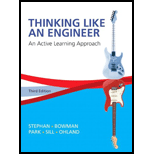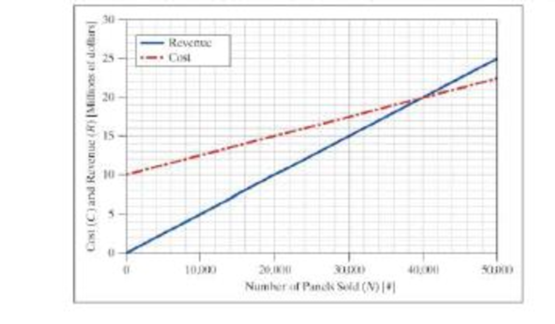
Concept explainers
One of the 14 Grand Challenges for Engineering as determined by a National Academy of Engineering committee is “Make Solar Energy Economical.” According to the NAE website: The solar “share of the total energy market remains rather small, well below 1 percent of total energy consumption, compared with roughly 85 percent from oil, natural gas, and coal ... today’s commercial solar cells ... typically convert sunlight into electricity with an efficiency of only 10 percent to 20 percent... Given their manufacturing costs, modules of today s cells... would produce electricity at a cost roughly 3 to 6 times higher than current prices ... To make solar economically competitive, engineers must find ways to improve the efficiency of the cells and to lower their manufacturing costs.”
The following graph shows a breakeven analysis for a company panning to manufacture modular photoelectric panels. A copy of this graph has been provided online; you may use one of these graphs or use graph paper as directed by you instructor.
- a. What is the fixed cost incurred in manufacturing the photoelectric panels?
- b. How much does it cost to manufacture each photoelectric panel?
- c. What is the sale price of one photoelectric panel?
- d. If the company makes and sells 30,000 panes, is the-e a net loss or profit, and how much?
While the company is still in the planning stages, the government starts a program to stimulate the economy and encourage green technologies. In this case, the government agrees to reimburse the company $250 for each of the first 10,000 units sold.
- e. Sketch a modified revenue curve for this situation.
- f. Using this new revenue curve, how many units must the company make to break even’ Be sure to clearly indicate this point on the graph.

- g. Also using the new revenue curve, how many units must the company make and sell to make a profit of $1,500,000? Be sure to clearly indicate this point on the following graph.
Want to see the full answer?
Check out a sample textbook solution
Chapter 11 Solutions
Thinking Like an Engineer: An Active Learning Approach (3rd Edition)
Additional Engineering Textbook Solutions
Thermodynamics: An Engineering Approach
Automotive Technology: Principles, Diagnosis, And Service (6th Edition) (halderman Automotive Series)
Fluid Mechanics: Fundamentals and Applications
Mechanics of Materials (10th Edition)
Java: An Introduction to Problem Solving and Programming (8th Edition)
Starting Out with Programming Logic and Design (5th Edition) (What's New in Computer Science)
- Show all work pleasearrow_forwardDraw top, side, front view With pen(cil) and paper Multi view drawing and handwriting all of itarrow_forwardA wheel of diameter 150.0 mm and width 37.00 mm carrying a load 2.200 kN rolls on a flat rail. Take the wheel material as steel and the rail material as cast iron. Assume the figure given, which is based on a Poisson's ratio of 0.3, is applicable to estimate the depth at which the maximum shear stress occurs for these materials. At this critical depth, calculate the Hertzian stresses σr, σy, σz, and Tmax for the wheel. 1.0 0.8 0, т Ratio of stress to Pmax 0.4 0.6 90 69 0.2 0.5b b 1.5b Tmax 2b Distance from contact surface The Hertizian stresses are as follows: 02 = or = -23.8 psi for the wheel =| necessary.) σy for the wheel =| MPa σz for the wheel = MPa V4 for the wheel = | MPa 2.5b ཡི 3b MPa (Include a minus sign ifarrow_forward
- 4. Solve for the support reactions at A and B. W1 600 lb/ft W2 150 lb/ft A Barrow_forwardIn cold isostatic pressing, the mold is most typically made of which one of the following: thermosetting polymer tool steel sheet metal textile rubberarrow_forwardThe coefficient of friction between the part and the tool in cold working tends to be: lower higher no different relative to its value in hot workingarrow_forward
- The force F={25i−45j+15k}F={25i−45j+15k} lblb acts at the end A of the pipe assembly shown in (Figure 1). Determine the magnitude of the component F1 which acts along the member AB. Determine the magnitude of the component F2 which acts perpendicular to the AB.arrow_forwardHi can you please help me with the attached question?arrow_forwardHi can you please help me with the attached question?arrow_forward
 Refrigeration and Air Conditioning Technology (Mi...Mechanical EngineeringISBN:9781305578296Author:John Tomczyk, Eugene Silberstein, Bill Whitman, Bill JohnsonPublisher:Cengage Learning
Refrigeration and Air Conditioning Technology (Mi...Mechanical EngineeringISBN:9781305578296Author:John Tomczyk, Eugene Silberstein, Bill Whitman, Bill JohnsonPublisher:Cengage Learning Principles of Heat Transfer (Activate Learning wi...Mechanical EngineeringISBN:9781305387102Author:Kreith, Frank; Manglik, Raj M.Publisher:Cengage Learning
Principles of Heat Transfer (Activate Learning wi...Mechanical EngineeringISBN:9781305387102Author:Kreith, Frank; Manglik, Raj M.Publisher:Cengage Learning Understanding Motor ControlsMechanical EngineeringISBN:9781337798686Author:Stephen L. HermanPublisher:Delmar Cengage Learning
Understanding Motor ControlsMechanical EngineeringISBN:9781337798686Author:Stephen L. HermanPublisher:Delmar Cengage Learning


